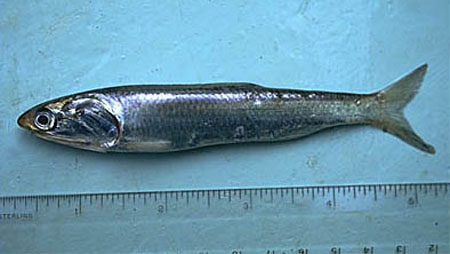Engraulis
mordax
Girard,
1854
Californian anchovy
View all media / Upload your photos and videos
Expand all
Classification / Names
Teleostei (teleosts) > Clupeiformes (Herrings) >
Engraulidae (Anchovies)
> Engraulinae
Etymology: Engraulis: Greek, eggraulis, -eos = anchovy (Ref. 45335).
mordax: Genus name from the Greek 'engraulis' meaning anchovy; species name from the Latin 'mordax' meaning biting (Ref. 27436).
More on author:
Girard.
Environment / milieu / depth range / climate zone / distribution range
Distribution
Northeast Pacific: northern Vancouver Island south to Cape San Lucas, Baja California, Mexico. Two subspecies recognized: Engraulis mordax mordax from British Columbia to Baja California and Engraulis mordax nanus in Bays of California.
Maps

Engraulis mordax / Native range
AquaMaps Data sources:
GBIF
OBIS
This map was computer-generated and has not yet been reviewed.

Engraulis mordax / Suitable habitat
AquaMaps Data sources:
GBIF
OBIS
This map was computer-generated and has not yet been reviewed.

Engraulis mordax / Point map
AquaMaps Data sources:
GBIF
OBIS
This map was computer-generated and has not yet been reviewed.

Engraulis mordax / Year 2050
AquaMaps Data sources:
GBIF
OBIS
This map was computer-generated and has not yet been reviewed.
Length at first maturity / Size / Weight / Age
Short description
Dorsal spines (total): 0; Dorsal soft rays (total): 14 - 19; Anal spines: 0; Anal soft rays: 19 - 26; Vertebrae: 43 - 47. Snout quite sharply pointed; maxilla moderate, tip sharply pointed, reaching to or almost to hind border of pre-operculum, projecting well beyond tip of second supra-maxilla; tip of lower jaw below nostril. gill rakers slender, long; absent on hind face of third epibranchial. Anal fin origin under about base of last dorsal fin ray. A silver stripe along flank, disappearing with age.
Biology
Usually found in coastal waters within about 30 km from shore, but as far out as 480 km, forming large, tightly packed schools. Enters bays and inlets. Feeds on euphausiids, copepods and decapod larvae, both by random filter-feeding and by 'pecking' at prey. Oviparous, epipelagic batch spawner (Ref. 6882). Spawns throughout the year, peaking once (Ref. 6882). Processed into fishmeal, used as bait for tuna, occasionally canned (Ref. 9298).
Life cycle and mating behavior
Spawns from British Colombia south to Magdalena Bay, Baja California, but most abundantly between Point Conception and Point San Juanico. There are two major spawning areas: 1) off southern California and northern Baja California and 2) off central and southern Baja California. Oviparous (Ref. 35602). Spawns either in inlets or offshore, throughout the year but mainly in winter and early spring, depending on hydrological conditions (preferably at 10 to 23.3° C in upper water layers and around 22.00 hours). Spawning occurs at night between 2000 and 0400 hour (Ref. 6882).
Main reference
Whitehead, P.J.P., G.J. Nelson and T. Wongratana 1988 FAO Species Catalogue. Vol. 7. Clupeoid fishes of the world (Suborder Clupeoidei). An annotated and illustrated catalogue of the herrings, sardines, pilchards, sprats, shads, anchovies and wolf-herrings. FAO Fish. Synop. 125(7/2):305-579. Rome: FAO. (Ref. 189)
IUCN Red List Status (Ref. 125652)
Data deficient (DD); date assessed: May 08 2020
CITES (Ref. 131153)
Not Evaluated
CMS (Ref. 116361)
Not Evaluated
Threat to humans
Harmless
More information
- Countries
- FAO areas
- Ecosystems
- Occurrences
- Introductions
- Stocks
- Ecology
- Diet
- Food items
- Food consumption
- Ration
- Common names
- Synonyms
- Metabolism
- Predators
- Ecotoxicology
- Reproduction
- Maturity
- Spawning
- Spawning aggregation
- Fecundity
- Eggs
- Egg development
- Age/Size
- Growth
- Length-weight
- Length-length
- Length-frequencies
- Morphometrics
- Morphology
- Larvae
- Larval dynamics
- Recruitment
- Abundance
- References
- Aquaculture
- Aquaculture profile
- Strains
- Genetics
- Allele frequencies
- Heritability
- Diseases
- Processing
- Mass conversion
- Vision
- Pictures
- Stamps, Coins Misc.
- Sounds
- Ciguatera
- Speed
- Swim. type
- Gill area
- Otoliths
- Brains
Estimates based on models
Preferred temperature (Ref. 123201): 7.6 - 14.9, mean 9 °C (based on 55 cells).
Phylogenetic diversity index (Ref. 82804): PD50 = 0.502 [Uniqueness, from 0.5 = low to 2.0 = high].
Bayesian length-weight: a=0.00550 (0.00348 - 0.00867), b=3.08 (2.94 - 3.22), in cm total length, based on LWR estimates for this species & Genus-body shape (Ref. 93245).
Trophic level (Ref. 69278): 3.1 ±0.3 se; Based on food items.
Generation time: 2.3 (1.6 - 2.6) years. Estimated as median ln(3)/K based on 17 growth studies.
Resilience (Ref. 120179): Medium, minimum population doubling time 1.4 - 4.4 years (rm=0.36; K=0.2-0.6; tm=1-4; tmax=7; Fec=4000).
Prior r = 0.50, 95% CL = 0.33 - 0.75, Based on 2 data-limited stock assessments.
Fishing vulnerability (Ref. 59153): Low vulnerability (24 of 100).
Climate vulnerability (Ref. 125649): Low vulnerability (22 of 100).
Price category (Ref. 80766): Low; Reliable: based on ex-vessel price for this species.
Nutrients (Ref. 124155): Calcium = 159 [69, 355] mg/100g; Iron = 1.23 [0.60, 2.84] mg/100g; Protein = 18.6 [17.4, 19.9] %; Omega3 = 0.841 [0.514, 1.405] g/100g; Selenium = 20.5 [9.8, 42.9] μg/100g; VitaminA = 13.9 [3.2, 56.6] μg/100g; Zinc = 1.01 [0.65, 1.56] mg/100g (wet weight);


